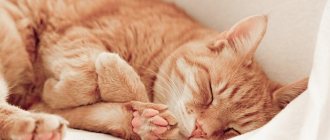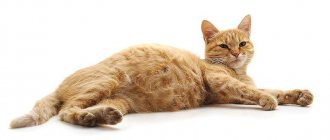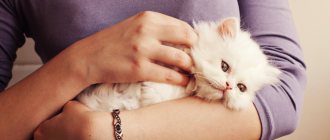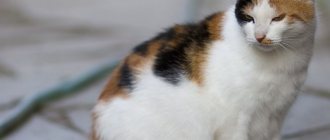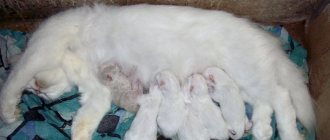Pets often develop various diseases throughout their lives. They differ from human diseases in symptoms and course. The owner can identify many signs on his own, so it is important to be attentive to the animal and monitor changes in behavior, appearance, and food preferences.
A lump near a cat's nipple is a common symptom that may indicate the presence of a benign or malignant tumor, as well as other serious diseases. In this article we will look at the causes of this problem and ways to normalize the pet’s condition.
Diseases accompanied by swelling of the mammary glands
A cat has four pairs of nipples on its stomach. Pathology is most often found in the two lower pairs - one, or much less often several, nipples increase in size or seals appear near them. This symptom may indicate the presence of the following diseases:
- Breast tumor. Compaction is often a symptom of a tumor. The increase in nipple size may vary for each animal - this sign does not affect the malignancy or benignity of the development of the disease. The most dangerous stage is characterized by dulling of the fur, enlargement of other mammary glands and the release of liquid from the nipples, which has a specific odor.
- Mastitis. In most cases, the disease develops in a cat after the birth of kittens; much less often, hardening is observed in a pregnant animal. The main reason why a nursing cat has hard mammary glands is milk stagnation. At the same time, the nipple becomes denser and hotter, covered with a network of cracks. The pet will try to avoid touching the abdomen, often licking the sore nipple. When you press it, a discharge with a curd consistency will appear.
- Mastopathy. Most often, this condition indicates the presence of cancer. The main symptom is enlargement of the mammary glands for no apparent reason or pregnancy. The initial stage of the disease is easy to miss, since the animal does not change its usual behavior.
We recommend the article: Why does a cat vomit foam?
The appearance of even small bumps near the nipples of cats should be taken seriously - the life of the animal depends on it.
Diagnostics
At the first stage of the disease, there may be no main externally noticeable symptoms (redness, foreign impurities in milk, refusal to feed kittens). However, if you notice unusual lethargy and decreased appetite in a nursing cat, this is a reason to definitely show your pet to a doctor. To diagnose mastitis, it is necessary to conduct an in-person examination and, if necessary, take a general blood test. The sooner mastitis is detected in a cat and treatment is prescribed, the fewer complications there will be and the faster the recovery period will pass.
Causes of seals
The main reasons that lead to the appearance of swelling can be identified:
- Negative effects on the animal’s body from excessive environmental pollution;
- Unbalanced diet, presence of low-quality food in the diet;
- Hereditary predisposition to the development of pathologies;
Often the reason why a cat has swollen mammary glands after kittens lies in the early separation of the offspring from the mother. Most often, this condition does not have a negative effect on the pet’s body and goes away on its own over time. In this case, it is recommended to express milk both independently and with the help of a veterinarian. You can also make lotions at room temperature from a decoction of oak bark or chamomile.
Causes
In addition to being a normal cause of pregnancy, swollen mammary glands can be a sign of a more serious internal problem in the cat. Your veterinarian will be best able to determine the exact cause of the swelling, allowing your cat to be diagnosed and treated more quickly. Reasons include:
- Pregnancy
- Mastitis (breast infection during breastfeeding)
- Galactostasis (accumulation of milk in the mammary gland during weaning)
- Mammary hypertrophy in cats (benign formations)
- Mammary cancer
- Breast hyperplasia (due to high progesterone levels)
Lump near the nipple of a cat photo
Treatment methods for purulent forms of the disease
You should consult your veterinarian about how to treat mastitis in a cat if it is complicated by severe symptoms, an abscess or cellulitis. Self-treatment of the purulent form of the disease can significantly aggravate the situation and provoke complications.
After a visual examination and diagnosis, the veterinarian may prescribe the following treatment methods:
- Injections with local anesthetic agents;
- Antibiotic therapy;
- A surgical intervention during which the formation is opened and treated with antiseptic drugs.
To cure mastitis as quickly as possible, it is necessary to do this comprehensively. In addition to prescribed medications, vitamins and mineral supplements are used to enhance the animal’s immunity. Particular attention should be paid to the balance of the cat's diet. During the treatment process, it is necessary to exclude walks in the open air, drafts and hypothermia.
Stages of tumor development
The development of any tumor can be divided into several successive stages:
- The neoplasm is very small, no more than 10 mm, no metastases have been identified;
- The tumor grows up to 30 mm, all the same, without the appearance of secondary lesions;
- A growth over 50 mm in size, the appearance of ulcers and the possibility of developing metastases in the lymph nodes are noted;
- Identification of secondary lesions in the liver and other organs of the animal;
By starting treatment in the first stages, you can prevent complications and completely normalize the animal’s condition.
Treatment of the disease at the initial stage
If the owner discovers mastitis in a cat, treatment at home can be carried out only in the early stages of the disease, until purulent or bloody discharge is released from the animal’s nipples and the body temperature is not elevated.
If the initial stage of mastitis is detected, the owner must take the following measures:
- Provide the cat with peace.
- Isolate the cat from the kittens, as milk from the inflamed glands is harmful to them. It is strictly not recommended to continue feeding mother's milk if it has a curd consistency, impurities of pus or blood, as this threatens the development of a serious illness in kittens.
- Limit the animal to water, especially in the first day.
- Remove liquid food from the diet, leaving cereals, dry food or canned food.
- Express as much milk as possible from diseased glands.
- Bandage the cat's nipples without restricting her movements. This is necessary to prevent germs and infection from entering the affected glands.
Gauze lotions made from a decoction of chamomile, sage or oak bark heated to a temperature of 38°C will help relieve pain in the chest area of a cat. A cabbage leaf applied to the inflamed area for 5 minutes will also help improve the condition of the animal.
If your pet's glands become hard, body temperature rises, and unusual discharge from the nipples appears, treatment of mastitis in a cat should be carried out under the supervision of a veterinarian. In some cases, hospitalization may be necessary.
Treatment options
For mastitis, the veterinarian, depending on the severity of the disease, may prescribe compresses, which the owner will do to the animal at home, following the instructions. In more advanced cases, complex treatment will be required, which includes antibiotics, as well as a mandatory course of vitamins necessary to improve well-being and strengthen the immune system.
In case of mastopathy, the doctor performs a biopsy, based on the results of which the following may be prescribed:
- Conservative therapy - carried out in case of a small chance of a malignant tumor, includes stabilization of hormonal levels by taking an individually selected vitamin complex.
- Surgical treatment is a surgical intervention in which the nipple and mammary gland are removed. These tissues are subsequently redirected for more detailed examination.
We recommend the article: Should I worry if my cat's whiskers fall out?
If a tumor is detected in the early stages of development, the veterinarian performs surgery to remove the mammary glands. If there are reasons why surgery is not possible, the cat is prescribed chemotherapy.
In order to choose an effective treatment method, it is important to accurately determine the reason why the cat’s nipples are swollen. Quite often the problem lies in the development of a malignant tumor and the appearance of cancer. It is not recommended to try to cure such diseases on your own without the help of a qualified specialist.
Features of pregnancy in cats in the early stages
You should not expect specific changes or signs in the early stages of pregnancy. The pregnancy process takes 60–65 days, and obvious signs are visible only from 3–4 weeks.
Early signs of pregnancy in cats are not observed in all cats and may include:
- Drowsiness – sleep duration increases by 2–4 hours. The norm is normally up to 14 hours a day.
- Loss of appetite - the animal readily drinks, accepts milk and broths, but refuses solid food. This is explained by a general loss of strength and active changes in hormonal levels.
- Reddening of the nipples - the mammary glands can swell, become hot and change color, up to a red or coral hue, see the photo for an example. The symptom manifests itself most clearly in the first pregnancy, while not all glands can “react” to pregnancy, but only the lower ones.
- Rarely nausea - usually the animal vomits in the morning, but not more than 3 times a day.
- Apathy towards other pets living in the home, aggressive reaction to cats.
This is interesting! Cats are excellent pregnancy tests. They smell the onset of pregnancy in humans and other animals in the earliest stages. If your cat shows tenderness towards a dog or another cat, does not leave her owner’s belly and behaves like a patron, it is quite possible that she anticipates the appearance of babies.
All doubts will be debunked by the third week of the intended pregnancy. The kittens reach noticeable sizes, begin to push each other, and the mother eats and sleeps a lot. By carefully palpating the abdominal cavity, you will feel the babies. At two weeks, pregnancy can be determined using an ultrasound or examination by a veterinarian; diagnosis is based on the enlargement of the uterus.
Signs of successful mating
The most successful period for mating is 3-5 days from the start of estrus. For the process to be successful, the cat must temporarily move in with the cat, and in the first few hours the animals may have misunderstandings and even fights. It is better to give the female time to calm down and get used to the new environment. It is best for the move to take place on the first day of estrus.
Moreover, the cat itself begins to flirt with the cat, provoking him to take active actions, then shows aggression, not letting him near her. Sometimes a cat covers a cat, several times, but the long-awaited success is not observed. In order to figure out whether full coverage has occurred or not, you need to know the signs of successful mating:
- After contact with the cat, the female begins to roll around on the floor.
- The mucous membranes of the genital organs swell and become brighter in color.
- The male completely loses interest in the cat, calmly moves away, and begins to lick himself with enthusiasm.
- If, nevertheless, the cat continues to pay attention to the female, he receives a sharp refusal.
- The cat may lose its appetite and become lethargic within 4 days.
If your cat has a fever and bleeding from the genitals, you should consult a veterinarian.
Disease prevention
Preventive measures help prevent the development of mastopathy. Pregnant and lactating females should be given less foods containing carbohydrates. A balanced diet must be agreed upon in advance with your veterinarian. Before mating, both the cat and the cat must be treated for fleas and intestinal parasites. Kittens sucking milk must be shifted from one nipple to another - this will ensure an even release of milk.
A lactating, nulliparous or sterilized female needs to change the bedding on time, wash water bowls and dishes. This will help to comply with sanitary and hygienic standards. To avoid stagnation, a nursing cat is given a massage daily.
Treatment
If mastitis is detected in a timely manner and a visit to a veterinary clinic is performed, surgical intervention can be avoided.
Often only conservative methods are sufficient. In order to choose the right treatment regimen, the owner is usually asked to tell how the birth and pregnancy went, and they are asked general questions about the cat’s health. This allows you to identify the cause of mastitis and prescribe the correct treatment. This means that it will facilitate and speed up the recovery process for your pet after an illness. Before you start taking medications, your cat will have to undergo tests. To do this, a drop of fluid from the mammary glands is taken for laboratory testing. These actions reveal the nature of inflammation.
After the preparatory stage and receipt of test results, the doctor prescribes treatment. If mastitis becomes severe, antibiotics are prescribed. Such measures make it possible to stop the inflammatory process and prevent its spread to surrounding tissues. As an auxiliary therapy the following is prescribed:
- massage;
- expressing milk;
- washing inflamed areas with infusions of medicinal plants (chamomile, sage, oak bark);
- treating nipples with products for external use that relieve inflammation and external symptoms.
It is recommended that cats reduce the amount of water they consume. Temporarily switch to feeding dry ready-made formulas.
Only the most severe forms require surgical intervention, when mastitis develops in several mammary glands at once, they become clogged, and impurities of blood and pus appear in the milk. In this case, kittens are taken away from their mother without fail.
When should you contact a veterinarian immediately?
At this time, the cat especially needs a caring attitude from the owner. If she exhibits the following signs, you should call your veterinarian immediately:
- The pet refuses to eat for more than 2 days.
- Fever, above 39 degrees.
- The cat drinks a large amount of fluid and at the same time breathes heavily.
- The female licks herself very often, and dark discharge is observed from the loop. If the discharge is red, you should urgently take it to the clinic.
Attentive attitude to the animal after mating will help to easily determine the presence of pregnancy. Only a specialist will give more accurate information; he will also recommend methods of caring for the cat, tell you how to properly help her prepare for a difficult moment, and give recommendations for helping the animal during childbirth.
How to tell if your pet is sick
You need to monitor your pet's behavior and well-being very carefully. Especially during such an important period of life as pregnancy and feeding offspring. This is always stressful for the body, which means the cat is more susceptible to various infections and diseases.
Symptoms of mastitis in the first stage:
- redness of the nipples;
- slight swelling and compaction;
- increase in body temperature;
- the occurrence of microcracks;
- discharge of a curdled mass when pressing on the chest.
The pet reacts painfully to any touch and often licks its tummy.
As mastitis moves to the next stage, redness and swelling increase, the temperature consistently exceeds the norm by at least 1C, and the tissue around the mammary glands becomes very hard. When pressed, a yellowish or grayish liquid with drops of blood or pus is released.
In these cases, immediate contact with a veterinarian is required. If this is not done, the disease becomes more severe. The animal shows the first signs of intoxication of the body - apathy, fever, weakness.
How to avoid illness
In order to avoid developing mastitis, you need to take some precautions that will help avoid problems in the future. Very often the cause of the disease is hypothermia, so a pregnant or lactating cat should live in a warm and dry room without drafts. It is better to move a pet living outside for a while indoors.
The second common cause of mastitis is infection. Kittens may accidentally scratch or damage the skin around their nipples while feeding. This, in turn, will lead to infection in the wounds and inflammation. You can avoid this outcome by regularly removing animal bedding and washing the kittens’ paws. A person should wash their hands thoroughly before touching a cat's belly.
A preventive measure that is of great importance is a proper balanced diet. You can choose special dry food for your pet. It would be good if it belongs to the premium class. Before purchasing a mixture, it is better to consult a veterinarian or breeder so as not to harm the health of the animal.
It is very important to wean kittens correctly. When babies begin to eat on their own, the cat's mammary glands need to be bandaged. This way you can reduce the amount of milk produced and protect your pet from infection.
Mastitis
Mastitis occurs due to stagnation of breast milk, infection with E. coli or staphylococcus. The disease is accompanied by:
- swelling of the mammary glands;
- increasing them in size;
- redness, cracking skin;
- increased temperature;
- discharge from the chest mixed with pus;
- in some cases - by compactions that can be felt during palpation.
Cats' behavior changes - they become apathetic, lethargic, and their appetite decreases. Touching the mammary glands with your fingers causes severe pain to the animal.
With mastitis, the ducts become inflamed and decrease in diameter, which impedes the flow of milk and leads to its curdling. As a result, the chest hardens, the cat begins to feel feverish, and she looks for a secluded place.
Untreated mastitis is dangerous due to degeneration into a malignant neoplasm and sepsis. Only a veterinarian can accurately diagnose the disease and prescribe the necessary therapy.
At the initial stage, owners can help the pet express milk by lightly pressing and massaging the nipple. This can be done if the animal does not have a fever. To stop lactation, apply a tight bandage to the mammary glands. The amount of fluid consumed by the female will have to be reduced for some time.
Preventive measures
To prevent neoplasms and early diagnosis of diseases, you should:
- Sterilize your cat before her first heat;
- do not use hormonal drugs without the advice of a doctor;
- see a veterinarian annually;
- monitor the cat’s weight, do not overfeed;
- provide active exercise in the fresh air.
A cat can lead a full life even with a diagnosis of a tumor and live long enough if the owners treat it in a timely manner.
Please rate the article. We tried our best:)
What to do
The first thing to do is to carefully examine the nipple yourself. To understand the nature of the disease, whether there is a tumor under the nipple and to see the cat’s reaction.
The next step is to take your pet to a doctor for examination . Only a specialist can accurately determine the cause of the tumor and decide what needs to be done. It may be necessary to remove breast tumors surgically if the cancer is in its early stages. Or, if it is mastitis, and the tumor is the remains of milk. You will need to take a course of antibiotics. In any case, both diagnosis and treatment are prescribed only by a veterinarian
